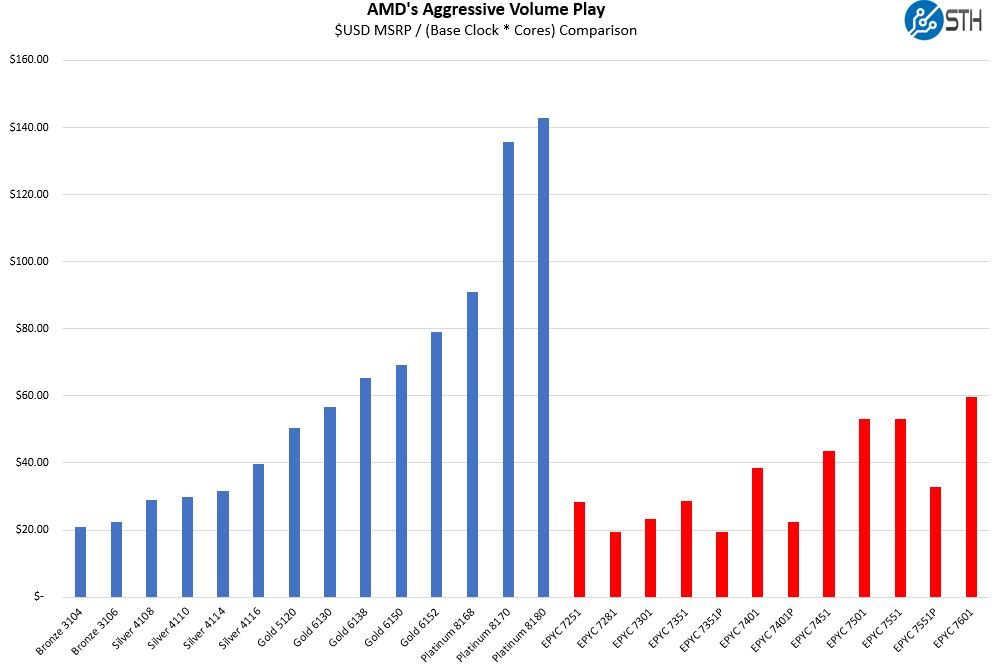AMD EPYC 7551P Power Consumption
The other side of the equation is power consumption. The AMD EPYC 7551P is putting up some impressive benchmark numbers, but that does have an associated cost. Here is what we saw on our PDU after a few runs:
- Idle: 81W
- 70% Load: 236W
- 100% Load: 282W
- Peak: 362W
Note these results were taken using a 208V Schneider Electric / APC PDU at 17.8C and 71% RH. Our testing window shown here had a +/- 0.3C and +/- 2% RH variance. The figures are certainly more than the Intel Xeon Gold 6100 line, but with that extra power consumption, AMD is delivering a more expandable platform and more performance.
We also wanted to note that this is almost the same as we saw in our AMD EPYC 7501 review piece.
AMD EPYC 7551P Market Positioning
AMD has a number of competitive vectors. The obvious competition is the Intel Xeon Scalable line. AMD also has non-P series parts that compete in this market.
AMD EPYC 7551P v. Intel Xeon
This is the chart that you need to see in order to grasp just how aggressive pricing is on the EPYC 7551P.

What you see here is that the per-core pricing of the AMD EPYC 7551P is between what Intel is charging for the Intel Xeon Silver 4114 and Xeon Silver 4116 on a per-core basis. Clock speeds between the Intel Xeon Silver range and the EPYC 7551P are similar but the Intel Xeon Silver 4100 line features a significantly reduced feature set despite being dual socket capable. At the end of the day, one can likely consolidate two dual Intel Xeon Silver 4110 servers into a single AMD EPYC 7551P server and realize absolutely massive savings. Performance wise, the AMD EPYC 7551P is on par or better than most of the multi-socket Xeon offerings that cost twice as much.
If you want to look at what AMD is doing in terms of single socket pricing, across its line and with respect to Intel, check out AMD EPYC’s Extraordinarily Aggressive Single Socket Mainstream Pricing.
In this price and performance range, Intel simply has no answer for the AMD EPYC 7551P. It is too good of a value.
AMD EPYC 7551P v. AMD EPYC
There is little doubt that the AMD EPYC 7551P is an enormous value. The upfront and TCO benefits of the 32 core single socket platform should be self-evident. The only real competition we see on the AMD EPYC side is with the AMD EPYC 7401P. The AMD EPYC 7401P is a 24 core part that retails for around $1100. If you do not need 32 cores of performance, the AMD EPYC 7401P can make sense as a lower cost per core alternative.
If you are running VMware with per-socket licensing, the EPYC 7551P is a worthwhile upgrade over the AMD EPYC 7351P and 7401P.
Final Words
Given the higher pricing, we can see some users looking at the delta between the AMD EPYC 7401P and EPYC 7551P and going with the former. At the same time, if you are paying for software licensing per socket, or if you have a higher-spec configuration with at least 8x 32GB DIMMs and a 100GbE NIC, the cost differential to upgrade from the 24 core parts to the 32 core part is relatively small. As the fastest “P” series EPYC to date, there is a large performance gap by adding 8 additional cores with each P SKU.
This is a case where Intel Xeon Scalable offers no good alternative. AMD’s strategy of having a single socket part capable of meeting or exceeding dual socket Intel Xeon configurations is validated with the EPYC 7551P. We are saying this after having every AMD EPYC single and dual socket configuration benchmarked and around 40 Intel Xeon Scalable configurations. Looking ahead to 2018 and 2019, the AMD EPYC 7551P and the EPYC 7000 series is a platform worth investing in.




Holy hell at that c ray chart with all the EPYCs. That’s EPYC. Good job STH.
What you talked about some, but I think you can talk about more is that the $1100 cost to upgrade over the 7401P is worth it if you’ve got lots of drives and RAM in a virtualization server
Looks like a scam. Buy Intel.
“The only real competition we see on the AMD EPYC side is with the AMD EPYC 7401P.”
I think the competition are actually dual-socket EPYC 7281/7301.
Thanh – That is a good point on the dual EPYC 16 core competition. Moving to dual socket has some benefits, but costs more operationally.
I wonder why Dell enumerates CPUs in this strange way? To me it looks like they like to do SMP system from NUMA hence enforcing wrong mapping (seen that on my old HP 585 first gen. Option to enforce SMP behaviour although machine was 4 nodes numa). But w/o testing and looking into BIOS options this is hard to claim of course…
Still hoping mining/cryptonight benchmarking becomes standard test
Almost any way you look at EPYC, AMD is to be complimented for an outstanding engineering achievement!
Any thoughts on why AMD hasn’t picked up more market shares in DC? I am guessing because the lead time is way longer?
Or are they all waiting for Zen2?